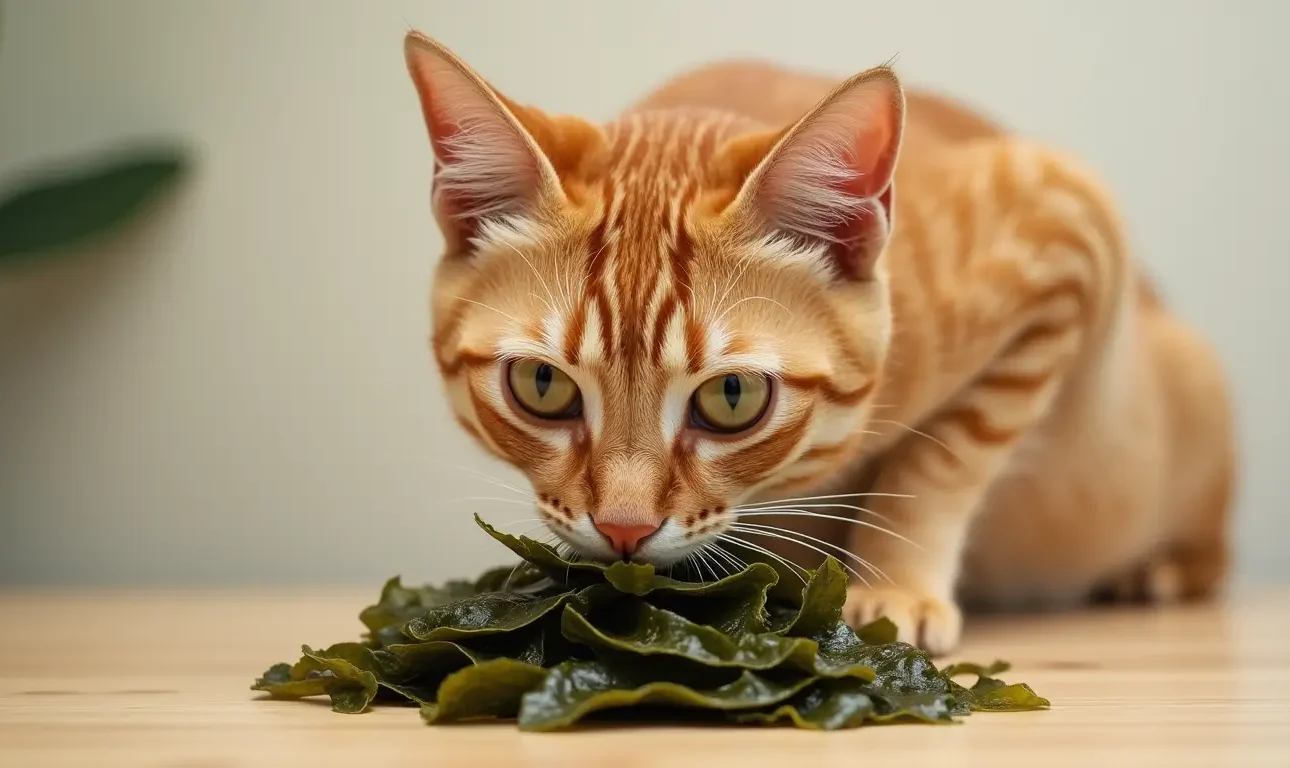As a pet owner, you might wonder if seaweed is good for your cat. This guide will look into seaweed’s role in a cat’s diet. We’ll cover its nutritional value, health benefits, and risks. By the end, you’ll know if adding seaweed to your cat’s meals is a good idea.
We’ll start by looking at different seaweed types and their nutrients. Then, we’ll talk about the safety of giving seaweed to cats. Next, we’ll explore its health benefits. Finally, we’ll discuss any risks or side effects of adding seaweed to your cat’s diet.
Table of Contents
Understanding Seaweed and Its Nutritional Value
If you’re thinking about adding cat safe seaweeds to your cat’s diet, knowing about seaweed is key. Seaweed is full of vitamins, minerals, and antioxidants. These can help improve your cat’s health and happiness.
Common Types of Edible Seaweed
The world of seaweed for cats is big and has many safe types. Here are a few:
- Kelp: A big, brown seaweed packed with iodine, vitamins, and minerals.
- Nori: Thin, dark green sheets used in sushi.
- Spirulina: A blue-green algae with lots of protein.
- Dulse: A reddish-purple seaweed with a tasty, umami taste.
Nutrient Composition of Seaweed
Seaweed is known for its rich nutrients. It has vitamins, minerals, and more. Here are some important ones:
- Iodine: Key for a healthy thyroid.
- Vitamins A, C, and E: Help keep the immune system strong.
- Minerals like iron, calcium, and magnesium: Good for bones and energy.
- Omega-3 fatty acids: Great for skin and fur.
Natural Sources of Seaweed in Cat Diets
While seaweed for cats isn’t usual, some cats might eat it naturally. Cats near the coast or hunting small sea creatures might eat seaweed. But, always talk to a vet before adding seaweed or new foods to your cat’s diet.
Can Cats Eat Seaweed Safely?
Seaweed can be good for cats, but we need to be careful. Before adding cat safe seaweeds to your cat’s food, let’s look at the safety first.
The type of seaweed matters a lot. Some, like nori, dulse, and spirulina, are okay for cats in small amounts. But, stay away from seaweeds with a lot of iodine, like kelp, as it can harm your cat’s thyroid.
Start with a little bit of seaweed to see how your cat likes it. Too much can upset their stomach. Watch how your cat reacts and adjust the amount as needed.
Make sure the seaweed is small and easy to chew. This prevents choking. Don’t give your cat big, hard pieces of seaweed.
| Seaweed Type | Suitability for Cats |
|---|---|
| Nori | Generally Safe |
| Dulse | Generally Safe |
| Spirulina | Generally Safe |
| Kelp | Not Recommended |
In short, cat safe seaweeds can be good for your cat’s diet. But, we must be careful and not overdo it. Always talk to your vet before adding seaweed to your cat’s meals.
Health Benefits of Seaweed for Felines
Adding seaweed for cats to their diet can bring many health perks. Seaweed’s special mix of nutrients is great for your cat’s digestion, thyroid health, and coat and skin. It makes their meals even better.
Digestive Health Improvements
Seaweed is full of fiber, which helps keep your cat’s digestive system in check. It can help with constipation or diarrhea. Plus, it supports good gut bacteria, boosting your cat’s immune system.
Thyroid Function Support
Many feline seaweed diet options are packed with iodine. This mineral is key for a healthy thyroid. Giving your cat seaweed can prevent thyroid problems and keep their metabolism in balance.
Coat and Skin Health Enhancement
Seaweed is rich in vitamins, minerals, and omega-fatty acids. These nutrients make your cat’s coat shiny and their skin soft. They help keep the skin and fur healthy, preventing dryness and flakiness.
By adding seaweed for cats to their diet, you can help your cat stay healthy. Always talk to your vet before changing your cat’s food.
Potential Risks and Side Effects
Seaweed can be good for cats, but there are risks and side effects to know. One big worry is iodine overexposure. Seaweed has a lot of iodine, and too much can harm your cat’s thyroid.
Some cats might also have allergic reactions to seaweed. Signs include skin problems, upset stomach, or breathing issues. Watch your cat closely when they eat seaweed and stop if they react badly.
Seaweed can also cause gastrointestinal troubles like vomiting, diarrhea, or constipation. This usually happens because of the seaweed’s high fiber or how it’s digested.
Before adding seaweed to your cat’s diet, talk to a vet. They can tell you which cat safe seaweeds to use and how much. They’ll also watch for any risks of seaweed for cats. This way, your cat can enjoy seaweed safely.
| Potential Risks of Seaweed for Cats | Symptoms to Watch For |
|---|---|
| Iodine Overexposure | Thyroid imbalances, other health issues |
| Allergic Reactions | Skin irritation, digestive disturbances, respiratory difficulties |
| Gastrointestinal Disturbances | Vomiting, diarrhea, constipation |
Conclusion
Seaweed might help your cat’s health in many ways, like better digestion and a shinier coat. But, adding seaweed to your cat’s diet should be done carefully. Always talk to your vet first to make sure it’s safe and right for your cat.
It’s key to remember that cats need a balanced diet that’s made just for them. Seaweed can be a good addition, but it can’t replace a high-quality cat food. Knowing about feline seaweed diet and seaweed for cats helps you make the best choices for your cat’s health and happiness.
Deciding to give your cat seaweed should be a team effort with your vet. You should think about what’s best for your cat and the possible benefits and risks. With careful planning, seaweed can be a great part of your cat’s diet, but always keep their nutritional needs in mind.
FAQ
Can cats eat seaweed?
Yes, cats can eat seaweed in small amounts. It’s a natural source of nutrients that can help their health.
What are the benefits of feeding seaweed to cats?
Seaweed can improve a cat’s digestion and thyroid function. It also makes their coat and skin healthier. The nutrients in seaweed, like iodine and vitamins, are good for cats.
What types of seaweed are safe for cats to eat?
Safe seaweed for cats includes kelp, nori, spirulina, and chlorella. Always choose organic and introduce it slowly and in small amounts.
Are there any risks or side effects of feeding seaweed to cats?
Seaweed is usually safe for cats in small amounts. But too much can cause iodine poisoning, allergies, or stomach problems. Always talk to your vet before adding seaweed to your cat’s diet.
How much seaweed can I feed my cat?
Start with a small amount, like a sprinkle, mixed into their food. Watch how your cat reacts and adjust as needed. Remember, a little seaweed is best for cats.






